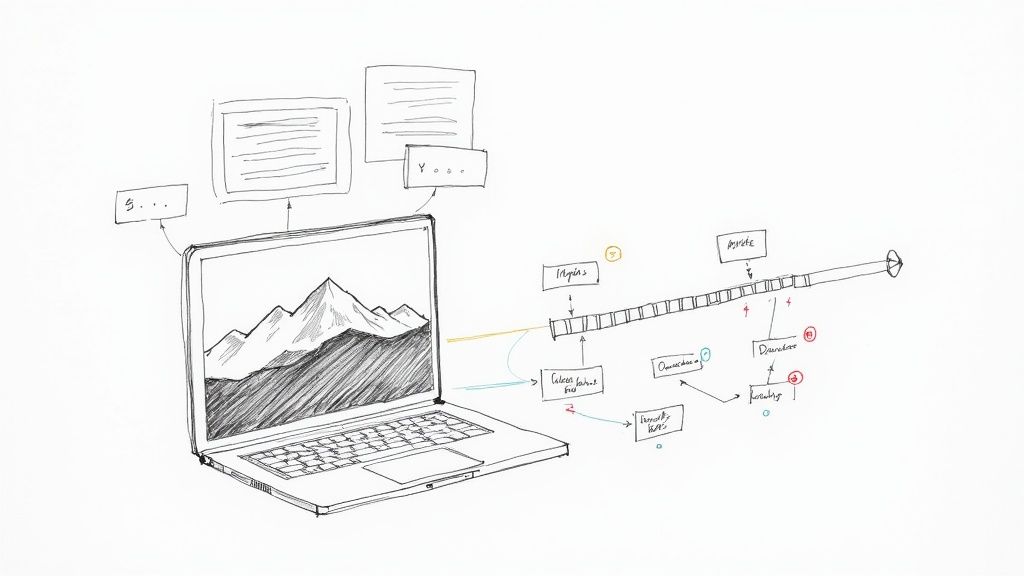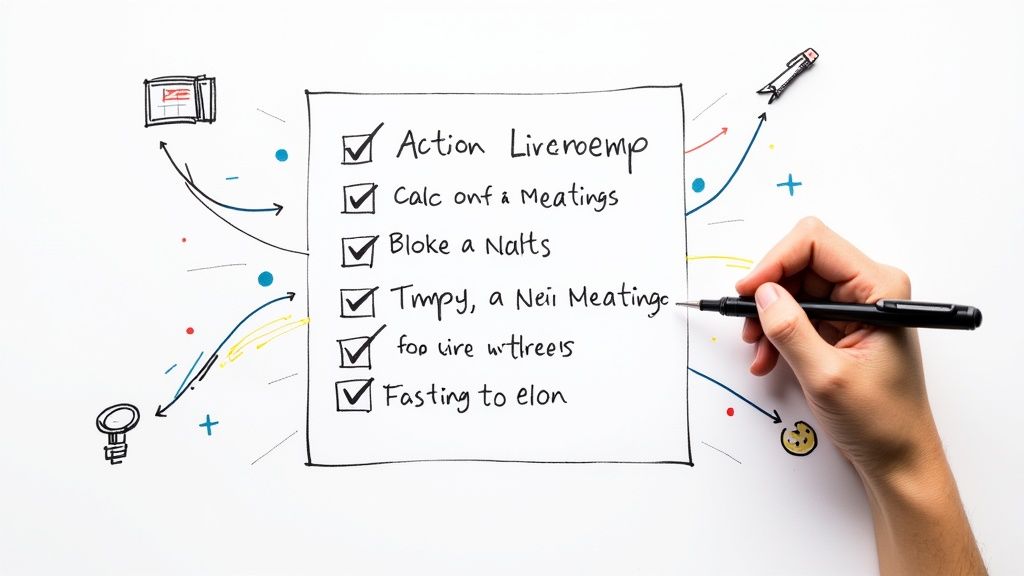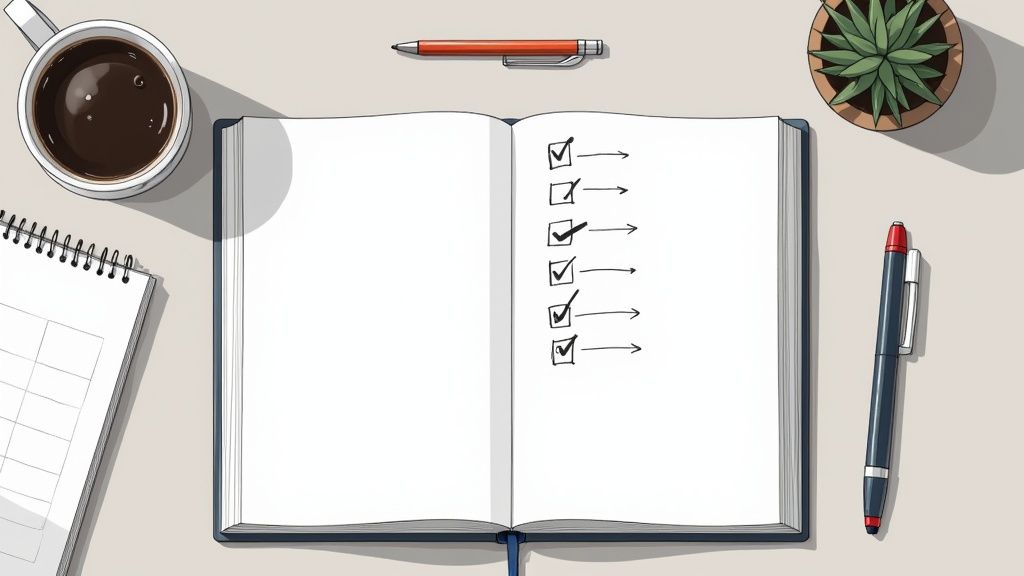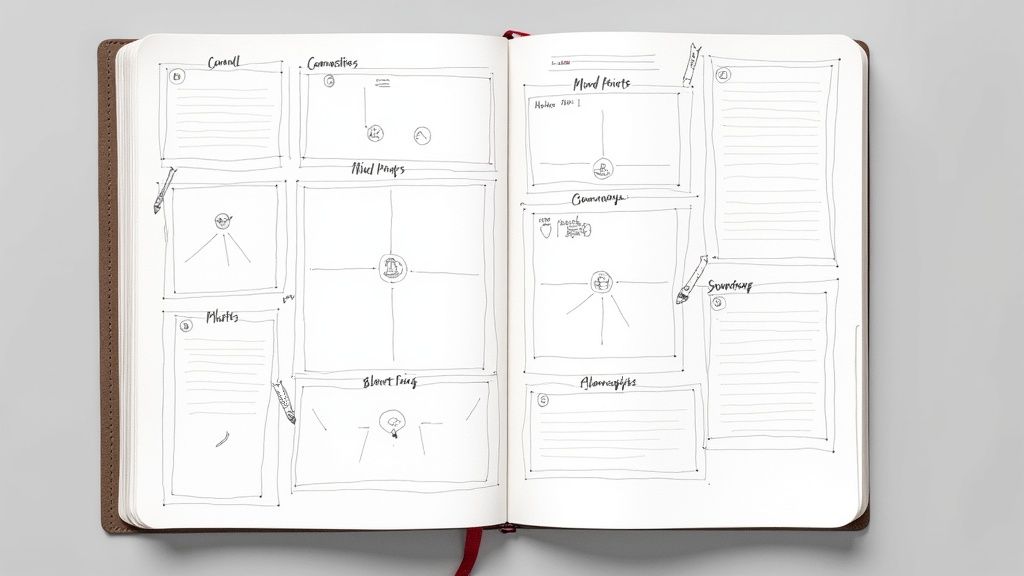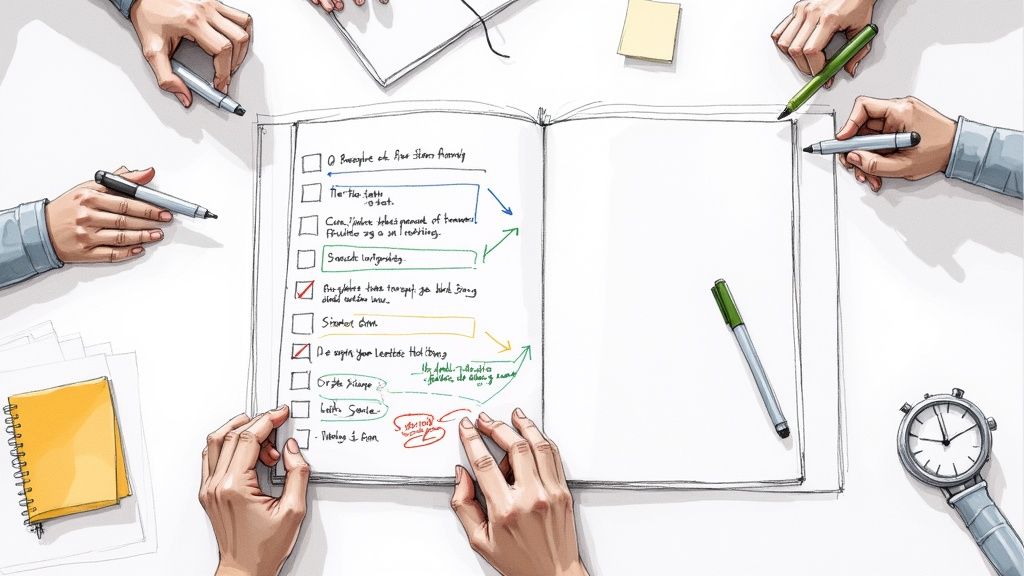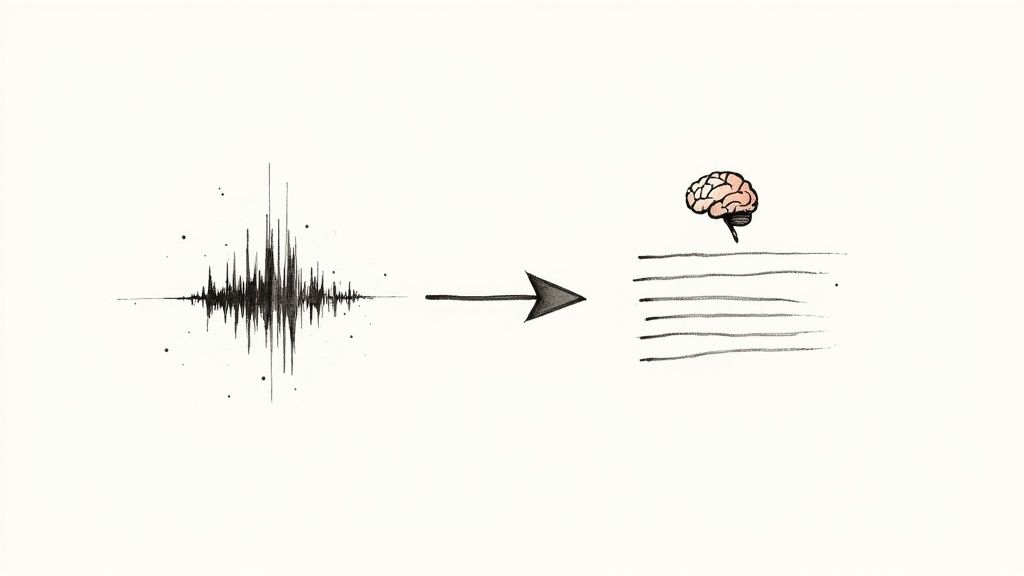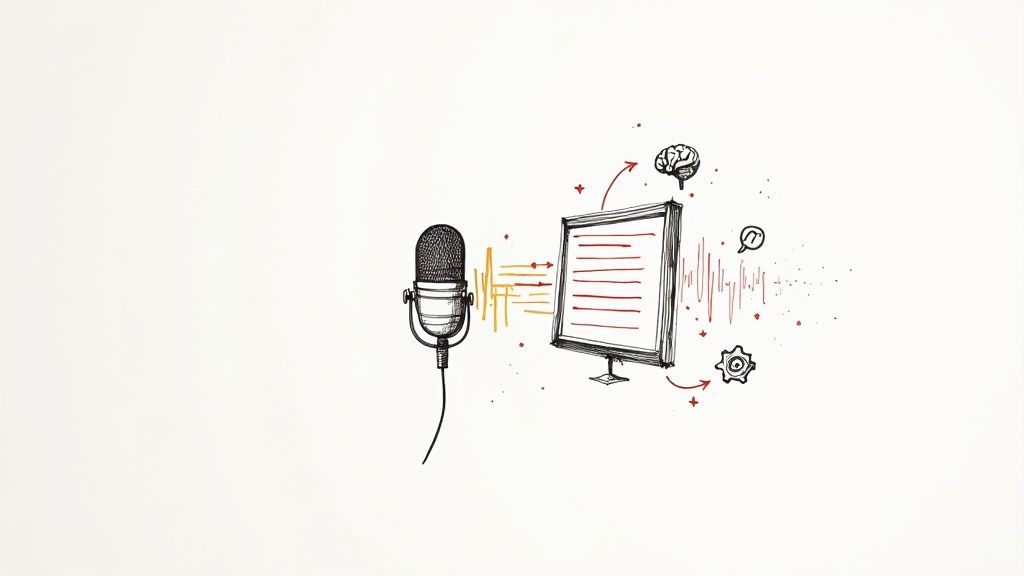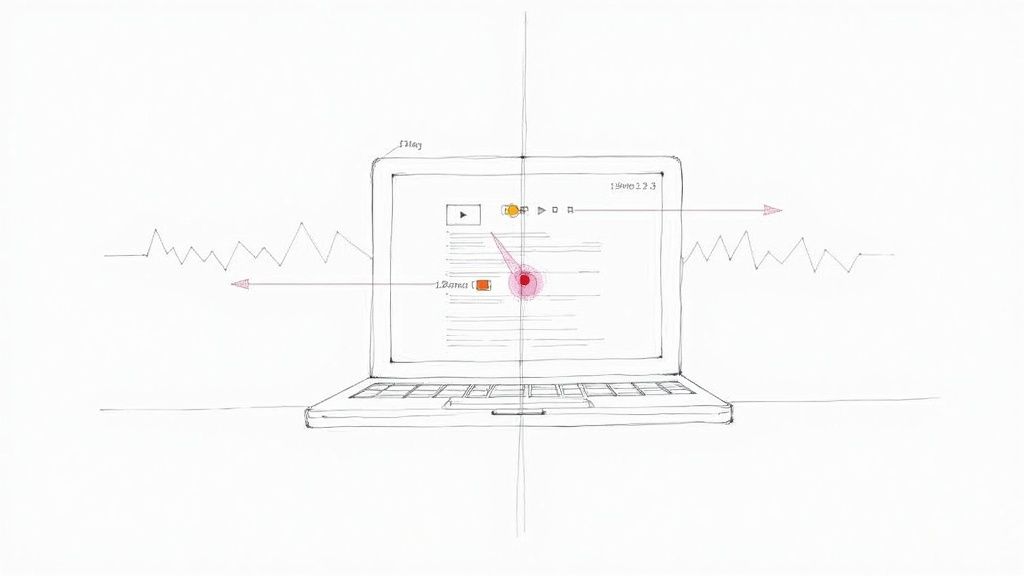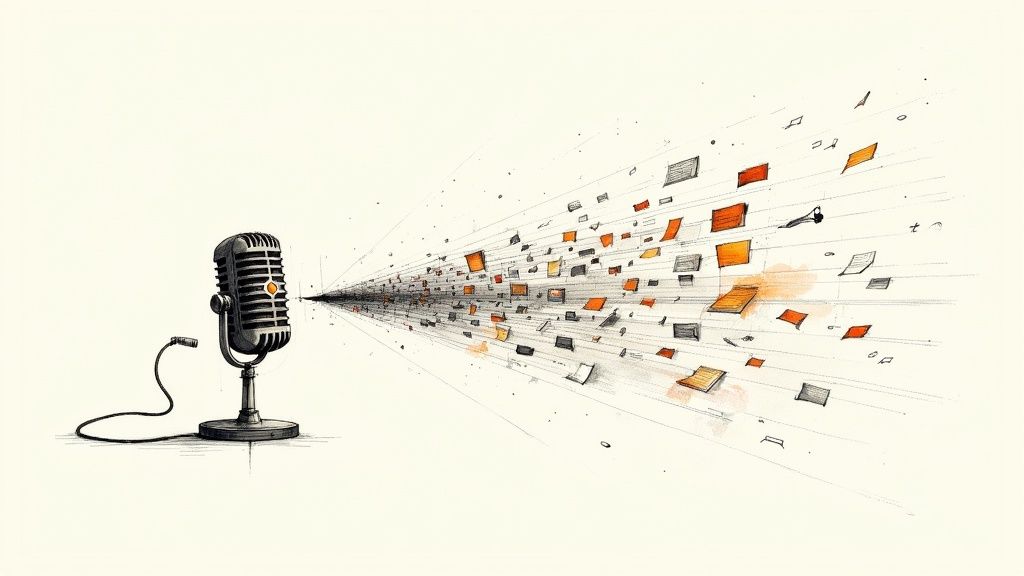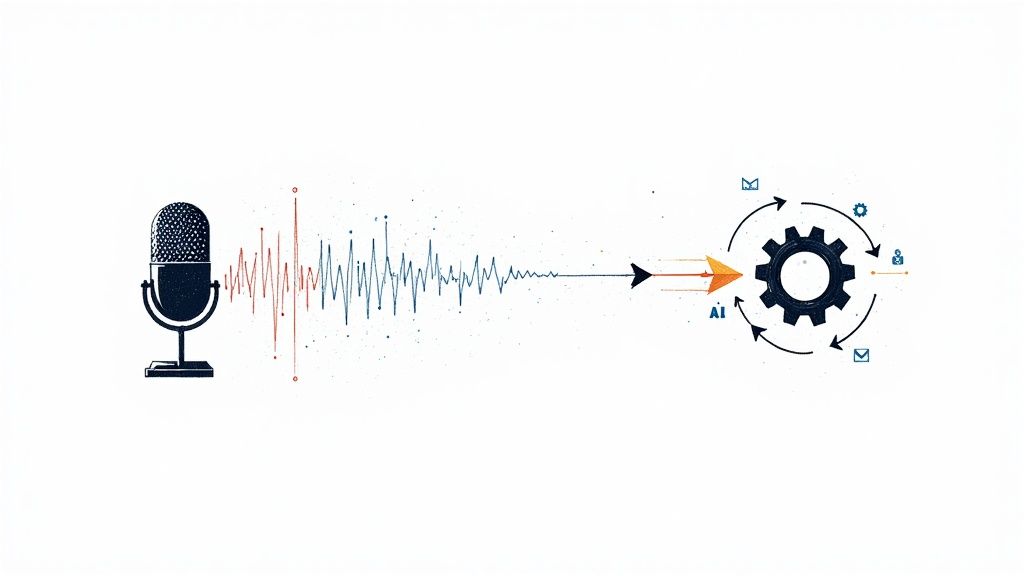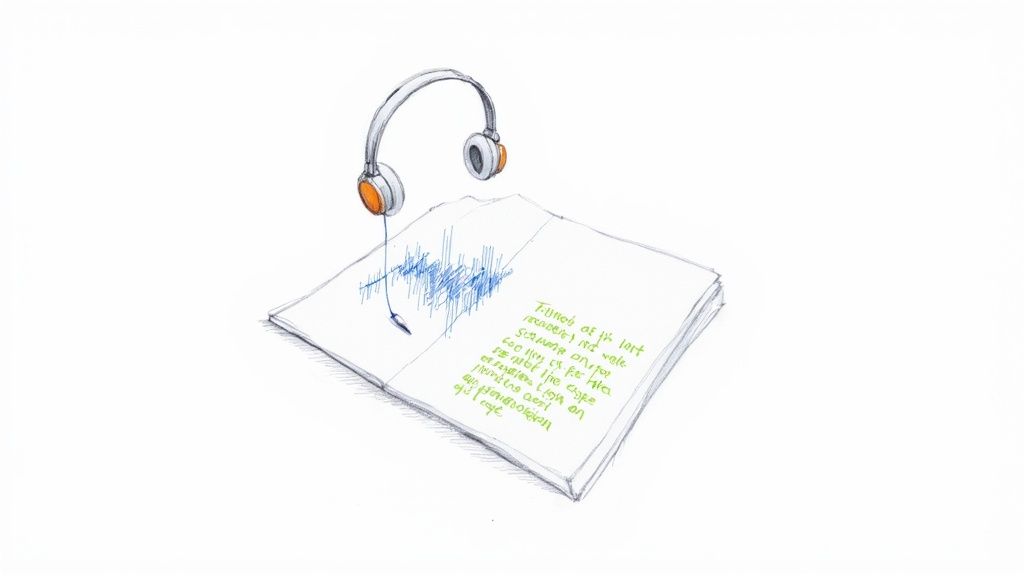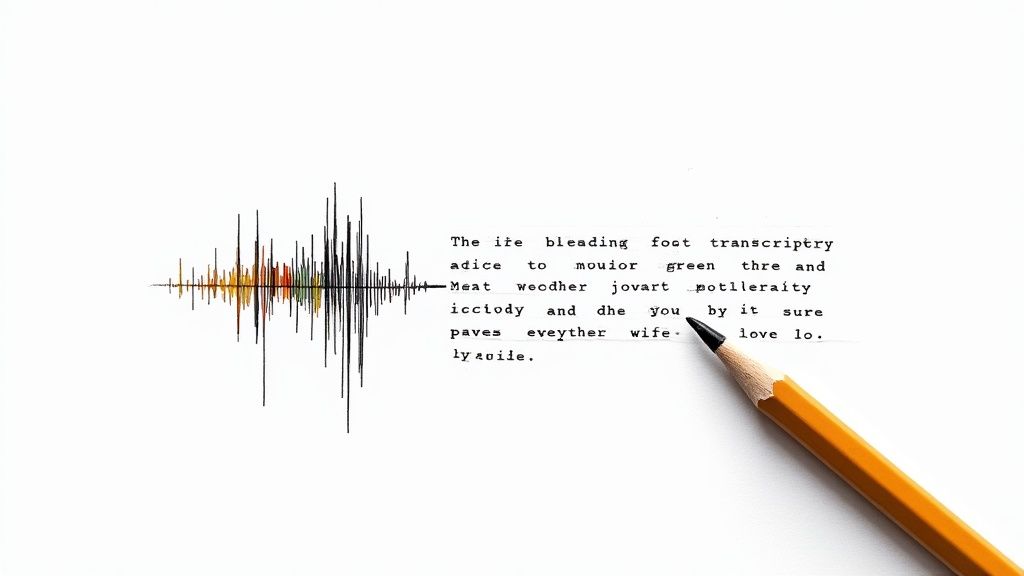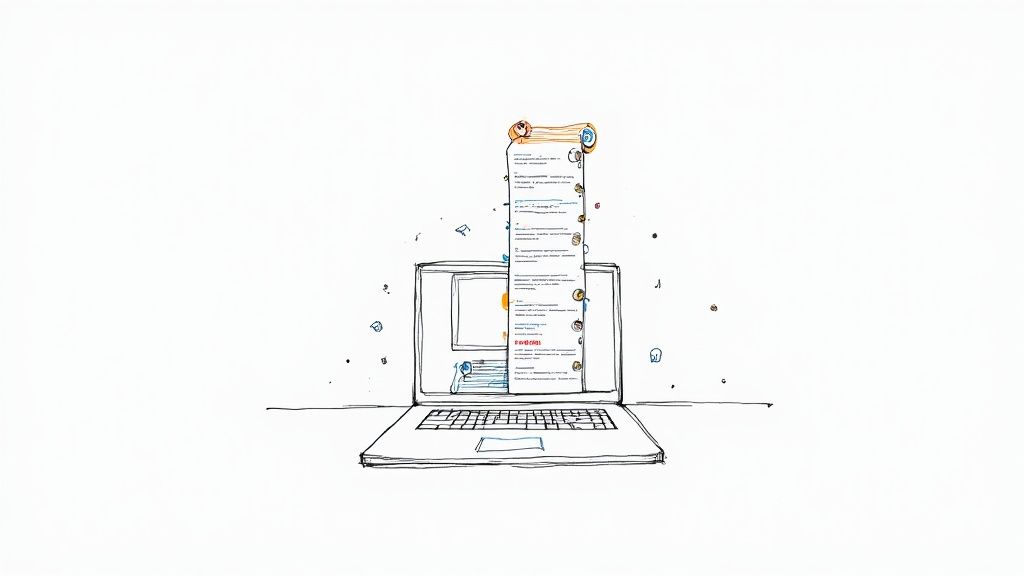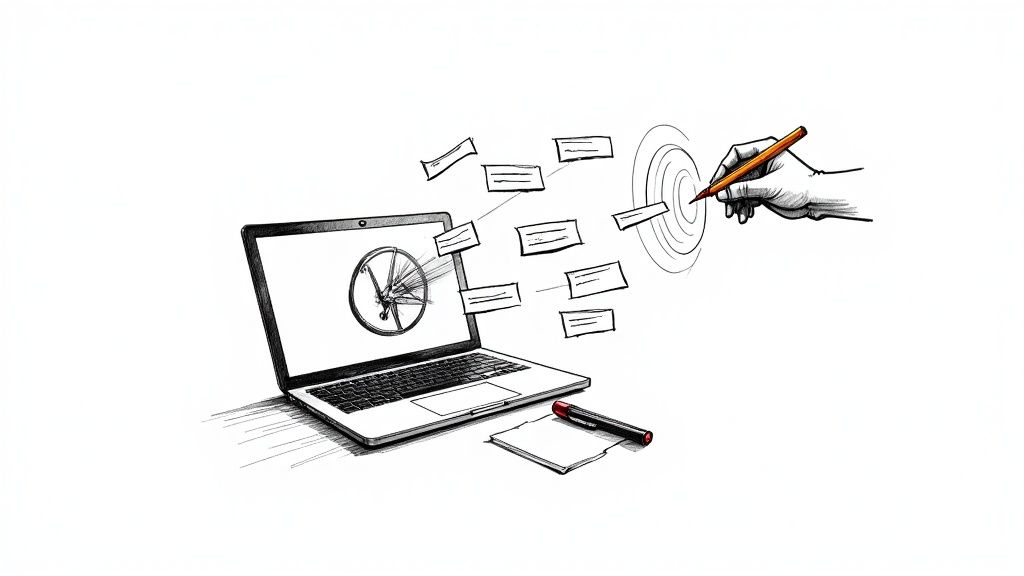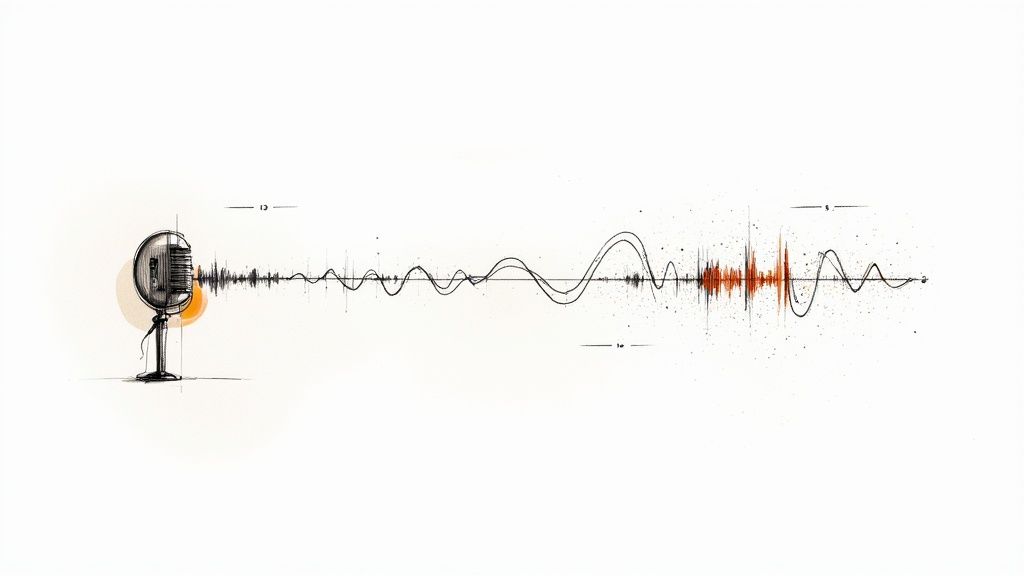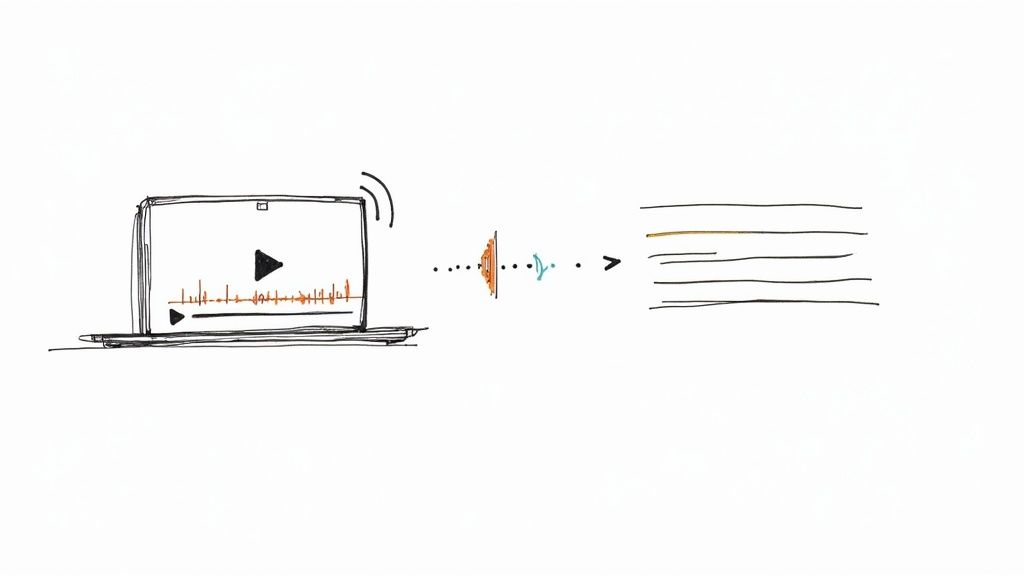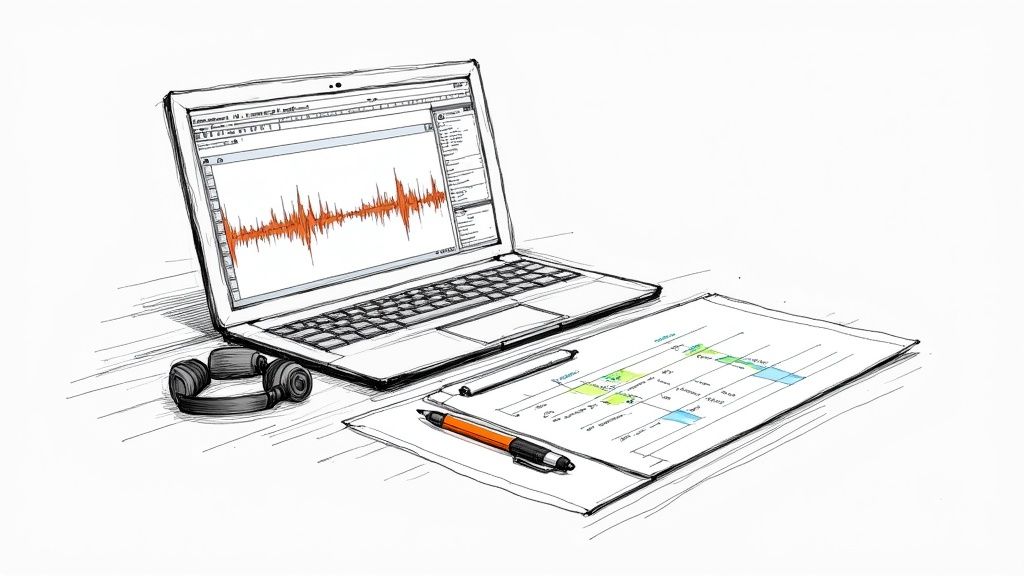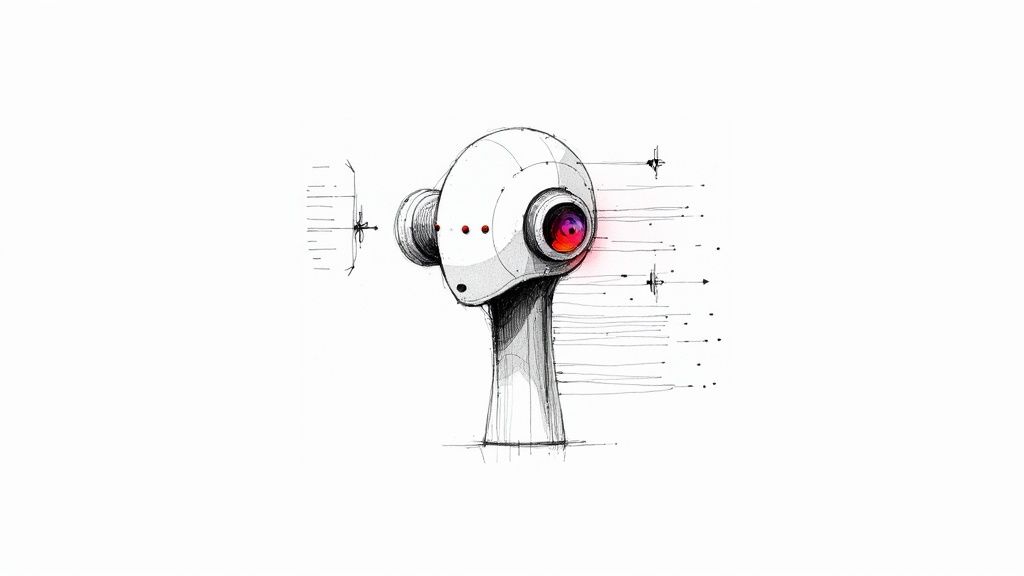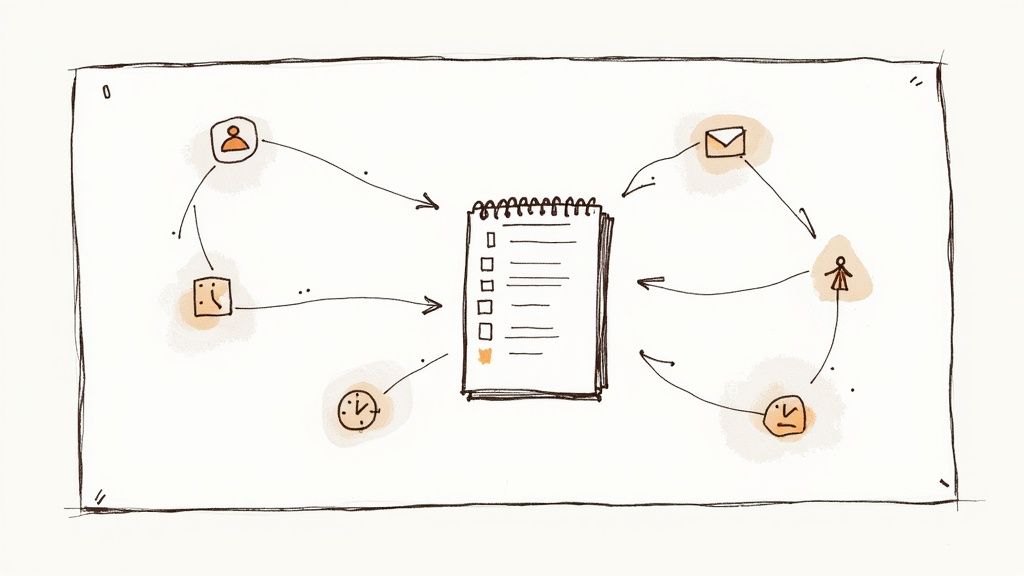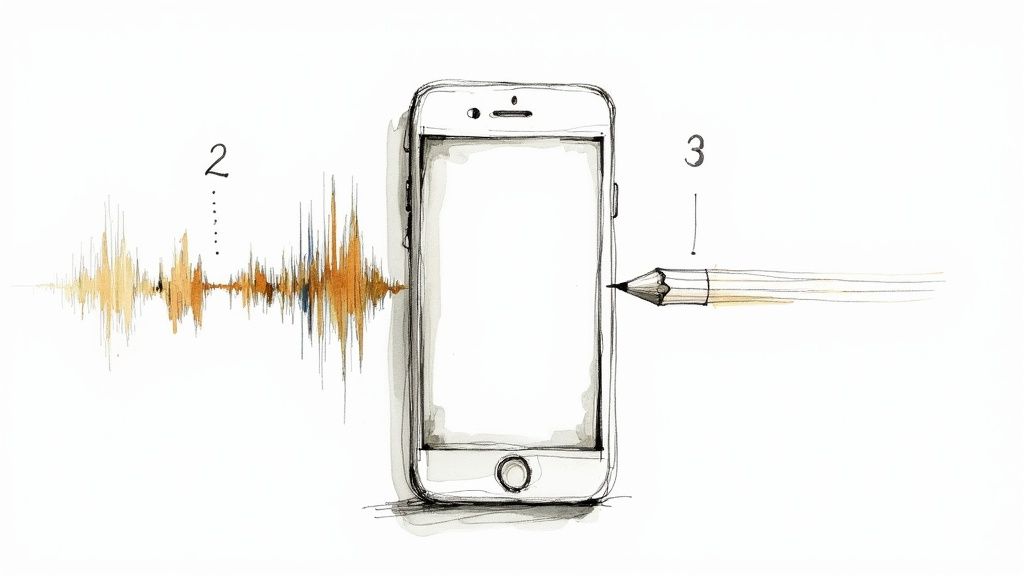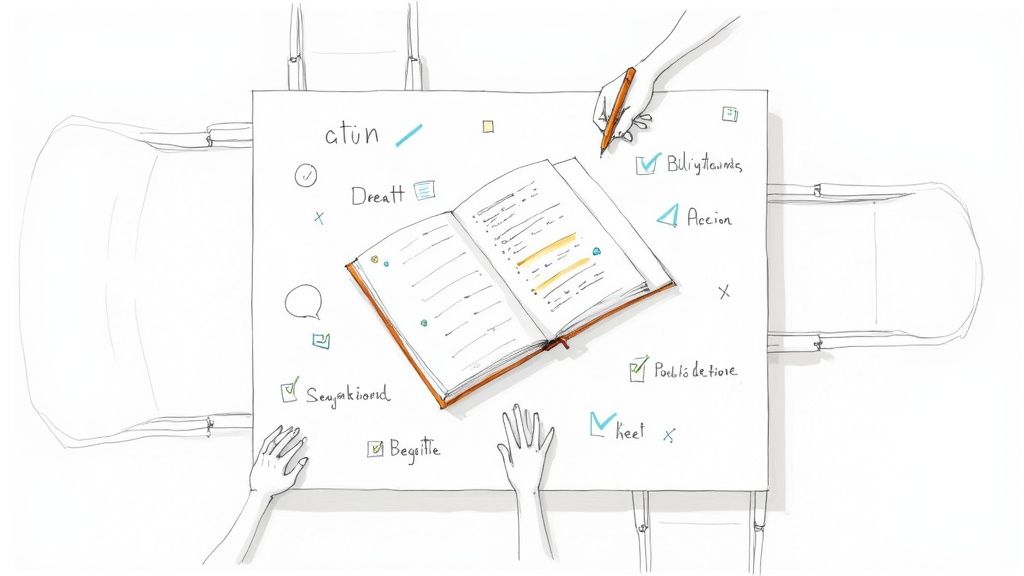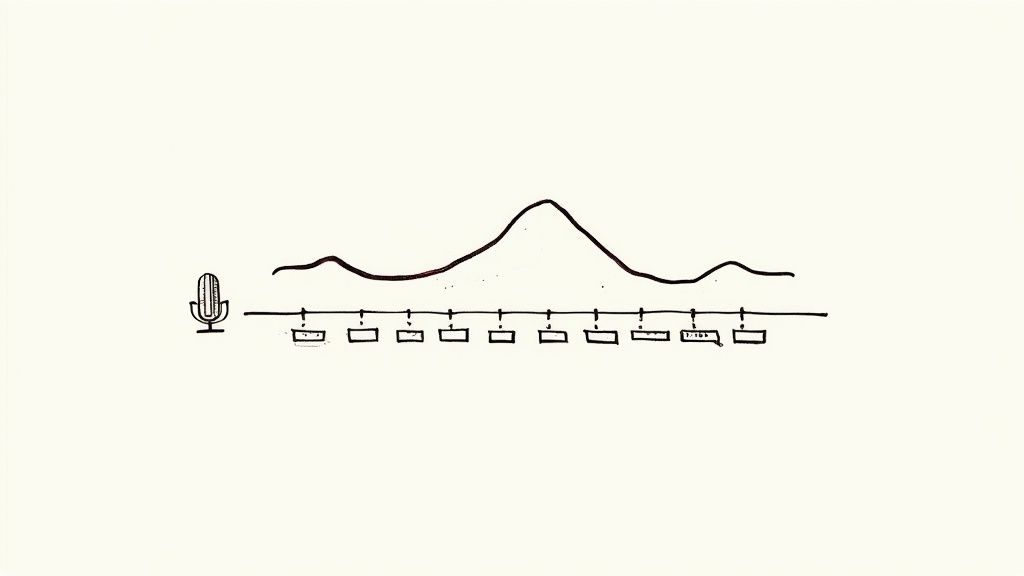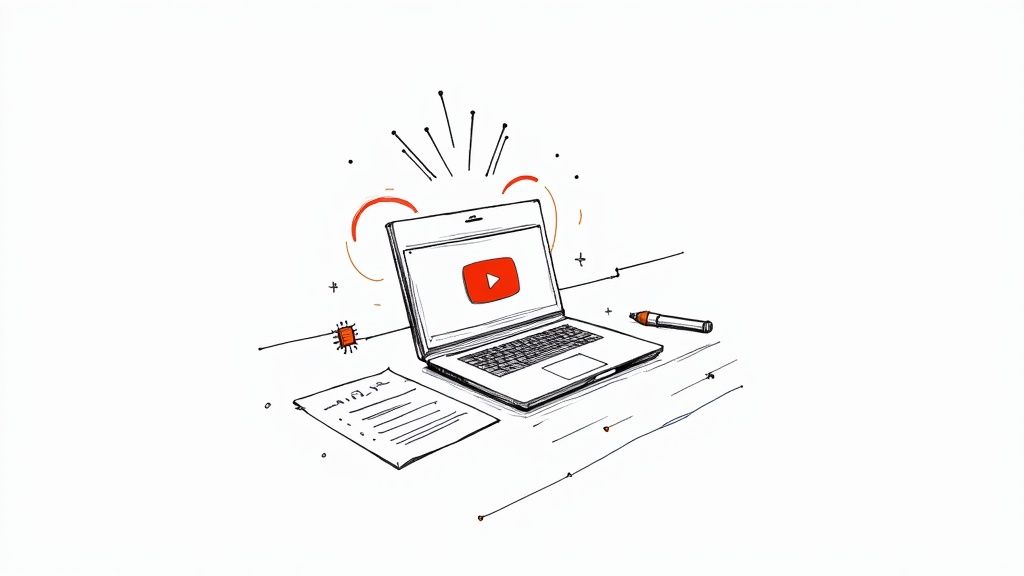
How to Use Notes for an Interview to Boost Confidence & Impress
Let’s get one thing straight: walking into an interview with a solid set of notes is probably the single biggest advantage you can give yourself. It's the line between nervously trying to remember a key achievement and confidently laying out exactly why you’re the right person for the job. From my experience on both sides of the hiring table, preparation is the most reliable predictor of success.
Why Interview Notes Are Your Secret Weapon
Interviews are high-pressure situations, plain and simple. It’s incredibly easy for your mind to go blank, forgetting that perfect project example or the insightful question you thought of last night. This is where strategic notes come in. They’re not just a crutch; they're a professional tool that tells the hiring manager you're prepared, genuinely interested, and organized.
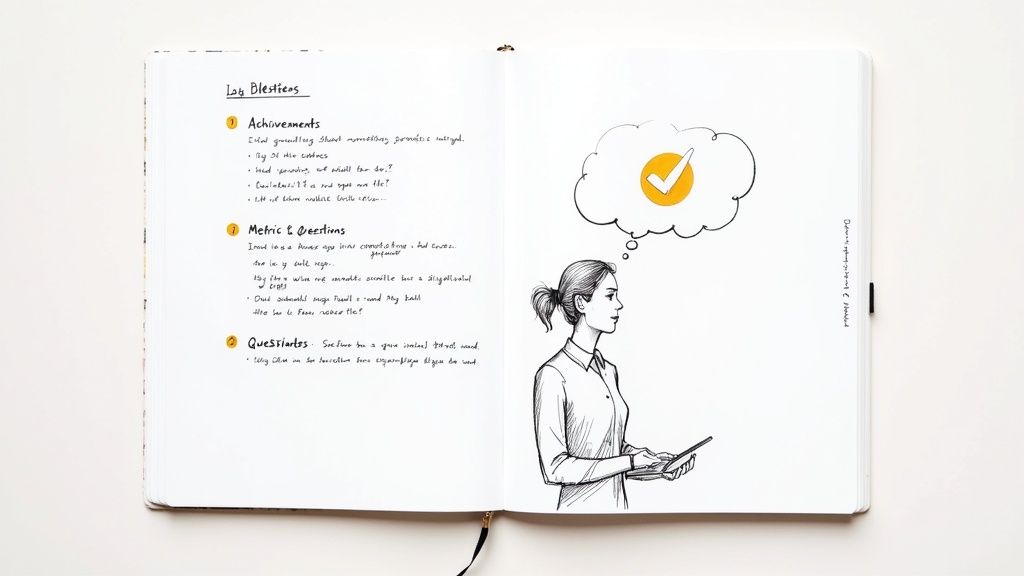
Showing up with well-thought-out points demonstrates that you respect their time and have put real effort into understanding the role. And the data backs this up. According to interview statistics from Simplilearn, candidates who come prepared with detailed notes are 30% more likely to land a job offer than those who don’t.
Let's quickly break down how this preparation gives you a real edge.
The Strategic Advantage of Interview Notes
Ultimately, having your notes ready gives you a roadmap for the conversation, allowing you to guide it toward your strengths.
Take Control of the Conversation
Instead of just reacting to questions as they come, your notes allow you to be proactive. Think of them as your personal briefing document for "Operation: Get This Job."
They help you:
- Remember Your Wins: It's tough to recall exact numbers on the spot. A quick note like "Increased lead conversion by 25% in Q3" is much stronger than "I helped improve our numbers."
- Ask Smarter Questions: Having a list of thoughtful questions ready proves you're thinking beyond the job description and are curious about the company's bigger picture.
- Deliver Powerful Stories: You can map your best career stories to the core requirements of the role ahead of time, ensuring your answers are always relevant and impactful.
From my experience, the goal isn't to read from a script. It's to have a well-organized reference that keeps you focused, confident, and ready to demonstrate why you are the best person for the job.
Crafting Your Pre-Interview Dossier
Great interview prep is so much more than a quick scan of the company’s "About Us" page. I've found that the best way to walk in feeling confident is to build a pre-interview dossier—basically, a single source of truth with everything you need. This document is the foundation for the notes for an interview you’ll actually bring with you, whether they're on a notepad or on your screen.

Think of it less as a script and more as your personal intelligence briefing. It's there to keep your key selling points and research top of mind. For those in super competitive fields, something like an ultimate guide to preparing for a consulting interview can offer a masterclass in structuring this kind of prep. The main goal is to organize your thoughts so you can easily reference them when the pressure is on. If you're looking for a digital tool to keep it all straight, check out some of the best note-taking apps to see what fits your style.
Deconstruct the Job Description
That job description? It's your treasure map. It tells you exactly what the hiring manager is looking for, so don't just read it—dissect it. I like to print it out or paste it into a fresh doc and go to town with a highlighter, marking up every single skill, responsibility, and qualification they mention.
Once you've done that, start grouping those highlighted terms into themes. You'll probably see clusters forming around concepts like "project management," "client communication," or "data analysis." This simple exercise is gold because it reveals the absolute core competencies they need, which is exactly what you need to focus on.
When you break down the job description, you stop guessing what they want and start knowing what they need. Your dossier should speak directly to those needs, backed up by your own experience.
Map Your Experience with the STAR Method
Okay, you've identified the key skills they're after. Now it's time to connect your own career highlights to each one. The best tool for this, hands down, is the STAR method (Situation, Task, Action, Result). It’s a simple but incredibly powerful way to structure your stories.
For every core competency you pulled from the job description, come up with at least one solid example from your past.
- Situation: Set the scene. Example: "Our team was struggling with a 15% drop in user engagement on a key feature."
- Task: What was your job? Example: "My task was to pinpoint the problem and pitch a solution, all within two weeks."
- Action: What did you actually do? Example: "I ran user surveys, dug into our heatmap data, and worked with the UX team to completely redesign the user flow."
- Result: What was the outcome? (Numbers are your friend here!) Example: "The changes I implemented boosted engagement by 20% in the first month and we got a ton of positive customer feedback."
Having these stories locked and loaded means you have compelling, evidence-based answers ready for almost any behavioral question they throw at you. Your actual interview notes should just have quick bullet-point reminders of these STAR stories, not the full script. This trick keeps you from sounding rehearsed while making sure you hit all the crucial points that prove your value.
Let's face it, the way we hire has completely changed. Recruiters are leaning heavily on technology for those first-pass screenings, which means the way you prep your interview notes has to be smarter and more strategic than ever.
It’s no longer just about jogging your memory; your notes need to be crafted to work for both the algorithms and the humans on the other side of the screen.
Here’s a wild statistic: by 2025, it's predicted that AI will manage a staggering 95% of initial candidate screenings. This isn't science fiction; it's happening now. You can dive deeper into the data behind this shift with these hiring and recruiting trends on TalentMsh.com.
What does this mean for you? It means you have to be deliberate about weaving the exact language from the job description into your talking points.
Getting Past the AI Gatekeepers
Think of the job description as your cheat sheet. Your first move should be to pull out all the essential skills, software, and qualifications mentioned. These are your keywords, and you need to make sure those exact terms are in your notes so they come up naturally when you speak.
- Mirror the Language: If the job post calls for "cross-functional team collaboration," have a note ready with a specific example of when you did just that.
- Quantify Everything: Don't just say you "improved sales." A much stronger note is "Drove 15% YoY sales growth." Numbers and metrics pop for both AI parsers and human reviewers.
A quick pro-tip: Ditch the full scripts. Stick to bullet points and key phrases. This forces you to speak naturally while still hitting all the crucial points that both the bots and the hiring manager are listening for.
Using On-Screen Notes Without Looking Like a Robot
One of the best parts of a video interview is the ability to use on-screen notes. But there's a real art to doing it well. You want to seem prepared, not like you're reading from a teleprompter.
The trick is to keep your notes incredibly brief and easy to scan. A simple digital sticky note or a split-screen with a basic text doc works perfectly.
To make sure you still look engaged, place your notes as close to your webcam as possible. This little maneuver keeps your eyes pointed toward the camera, which helps build a connection with the interviewer.
And if you’re juggling multiple interview rounds, keeping a clean record is a lifesaver. Using tools like the best interview transcription software can help you go back over previous chats to sharpen your notes for the next one.
Taking Effective Notes During the Interview
Once the interview kicks off, it's game time. Your focus needs to shift from prep mode to active listening. The trick is to capture the important stuff without losing eye contact or making the conversation feel stilted. Think of yourself as an engaged participant, not a court reporter.
You're not trying to write a transcript. Instead, focus on jotting down short, high-impact details. This means catching the names of your interviewers, specific projects they bring up, or any internal jargon and acronyms they use. These little nuggets are pure gold when it comes time to ask thoughtful questions and write a personalized thank-you note.
What to Actually Write Down
When you're in the moment, it's all about quality over quantity. Your notes should be a tool that helps you connect the dots between your experience and their specific problems, proving you were locked in and listening.
Here’s a quick list of what I always try to capture:
- Key Metrics: If a hiring manager mentions a goal like "increasing user retention by 15%," you absolutely want to write that down.
- Team Dynamics: Make a note if they talk about team size, reporting structures, or how they collaborate. It gives you a feel for the culture.
- Unexpected Questions: Jot down any question that catches you off guard. It's a huge clue into what they really care about.
- Your Follow-Up Ideas: As they talk, you'll naturally think of questions. Scribble them down so you don't forget.
A mental framework can be a lifesaver for structuring your answers on the fly, especially for those classic behavioral questions. This is where the STAR method comes in handy.

This simple model helps you tell a complete and compelling story by hitting the Situation, Task, Action, and Result of any experience you share. Just having those four letters jotted down can be enough to guide your answer. If you want to see how this works in a real-world context, check out these comprehensive note-taking examples that show how to put frameworks like this into practice.
Adapting Your Notes for Virtual Interviews
Let's face it, remote work isn't just a trend anymore; it's completely reshaped how we interview. The good news? This shift to virtual interviews is a golden opportunity to use your notes in a way that's far more seamless than fumbling with a notepad in a conference room. With a video call, your key points can be right there on your screen, ready to go.
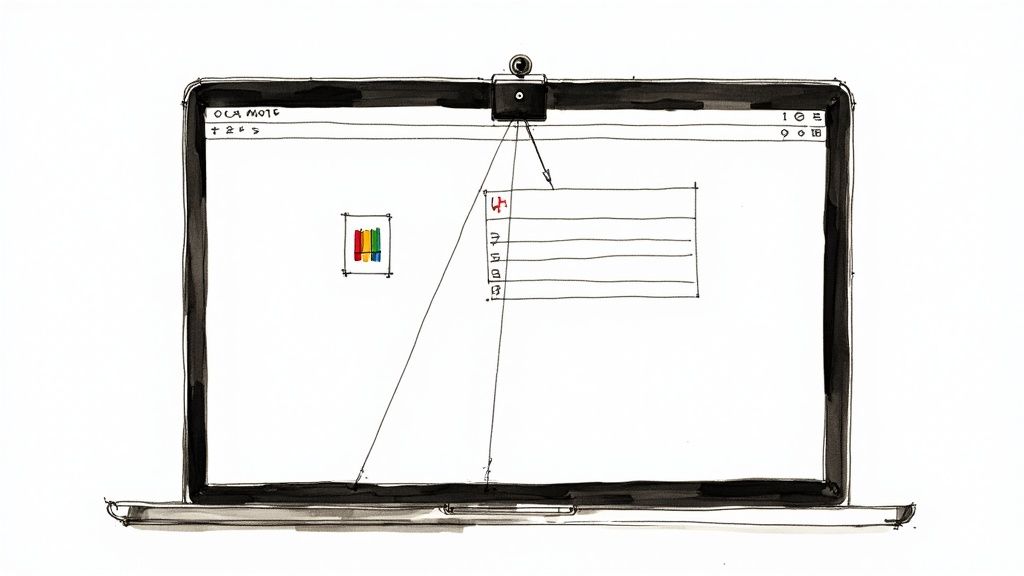
And this isn't changing anytime soon. Projections show that by the end of 2025, 70% of the workforce will be working remotely at least five days a month. This solidifies virtual interviews as a cornerstone of modern hiring. If you're interested in the data behind this workforce shift, check out the full hiring statistics on goodtime.io. What this really means is that getting comfortable with digital note-taking isn't just a nice-to-have skill—it's essential.
Choosing and Positioning Your Digital Notes
The real trick to using notes during a video call is to be subtle. You want it to look effortless, not like you're reading a script. The best tools for the job are often the most straightforward ones that don't crowd your screen or demand a lot of clicks.
- A Simple Text Editor: Sometimes, less is more. A basic app like Notepad on Windows or TextEdit on a Mac is perfect. You can easily resize the window and tuck it away near your webcam.
- Organizers like Notion or OneNote: If you're going through multiple interview rounds, these are fantastic. You can set up a single page for the company and just add new notes for each conversation, keeping everything tidy and in one spot.
Your goal is to glance, not read. Position your notes window at the top of your screen, as close to your computer’s camera as possible. This maintains the illusion of eye contact and keeps you looking engaged.
When you handle your notes this smoothly, you’re doing more than just staying on track. You’re subtly proving you’re a pro at remote work. It shows the interviewer you're organized, comfortable with technology, and proactive—all huge pluses for any remote role. Being able to seamlessly reference a key detail or ask a thoughtful, prepared question shows a level of professional competence that goes beyond just answering questions.
Answering Your Top Questions About Interview Notes
Even after all the prep work, it’s natural to feel a little hesitant about actually using your notes. Will it seem like you don't know your stuff? What if you end up relying on them too much? Let's clear up some of the most common concerns I hear from candidates.
The biggest hang-up is usually about perception. There's this fear that looking at notes makes you seem forgetful or, even worse, unprepared. But from a hiring manager's perspective, the opposite is almost always true. Well-structured notes for an interview show you’re organized, diligent, and genuinely invested in the opportunity.
An interviewer would much rather see you pause to glance at a well-organized thought than listen to a rambling, off-the-cuff answer. Think of your notes as a tool for clarity, not a crutch.
Is It Okay to Look at My Notes on a Video Call?
Yes, absolutely. In fact, virtual interviews make it incredibly easy to do this discreetly. The trick is to avoid reading from a script. Your on-screen notes should be for quick reference—a place for key phrases, important metrics, or the specific questions you plan to ask.
I always recommend using bullet points that you can scan in a split second. This approach lets you keep natural eye contact and maintain a conversational rhythm, all while making sure you don't forget that killer statistic you wanted to bring up.
What if They Ask a Question I Haven't Prepared For?
This is where your notes prove their real worth. They aren't just for canned answers; they're your personal archive of career highlights, core skills, and company research. When a curveball question comes your way, a quick glance can help you anchor your response in a relevant experience you've already jotted down.
You can often find more great perspectives on using tech and other best practices for interview note-taking on Parakeet AI's blog. Ultimately, your notes provide the building blocks you need to construct a thoughtful, confident answer to just about anything they throw at you.
Ready to take your interview preparation to the next level? Whisper AI transforms your practice sessions and post-interview reflections into searchable, summarized text. Capture every detail, identify areas for improvement, and walk into your next interview with unmatched confidence. Start transcribing for free today at whisperbot.ai.
